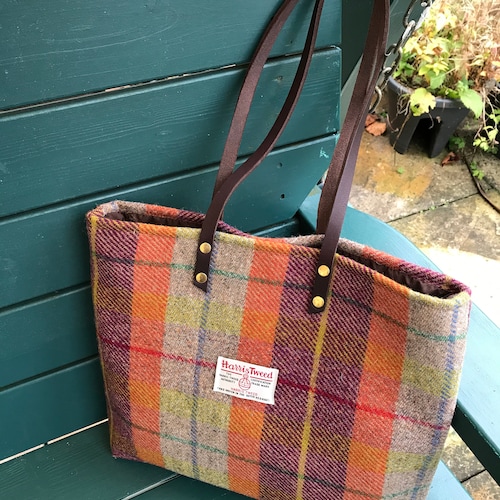Harris tweed purse, Harris tweed bag, orange purse, tartan purse, Harris tweed bag, Scottish gift, store gift for her, Harris tweed tote,
10 x 14 x 3
Beautifully hand crafted shoulder bag with real leather handles. This purse is great for day or evening. It can be worn casually or dressed up with cashmere. The handles are top grade leather and are riveted on with four brass rivets per handle. There is a super strong inter lining making the bag behave as a soft leather would. It is equally as strong as a leather bag and is both robust and beautiful. It has both a Harris tweed label and our Scotswhahae label. A gift that is sure to please young or old as Harris tweed is iconic and eternally on trend. Perhaps you would just like it for yourself..........why not?
HISTORY
For centuries, the islanders of Lewis and Harris, the Uists, Benbecula and Barra wove cloth known as clò-mòr - literally, "big cloth" in Scottish Gaelic - by hand. Originally woven by crofters, this cloth was woven for personal and practical uses and was ideal protection against the often cold climate of northern Scotland. The cloth was also used for trade or barter, eventually becoming a form of currency amongst islanders; it was not unusual for rents to be paid in blankets or lengths of clò-mòr.
By the end of the 18th century, the spinning of wool yarn from local raw materials had become a staple industry for crofters. Finished handmade cloth was exported to the Scottish mainland and traded, along with other commodities produced by the Islanders, such as goat and deer skins. As the Industrial Revolution reached Scotland, mainland manufacturers developed mechanised weaving methods, with weavers in the Outer Hebrides retaining their traditional processes. The islanders of Lewis and Harris had long been known for the quality of their handwoven fabrics, but up to the middle of the nineteenth century, this fabric was produced mainly for either home use or for trade and barter at the local market.
Upon the death of the 6th Earl of Dunmore in 1843, responsibility for his estate on the Isle of Harris passed to his wife, Lady Catherine Herbert. Lady Catherine noticed the marketing potential and high quality of the tweed cloth produced locally by two sisters from the village of Strond. Known as the Paisley Sisters after the town where they had trained, the fabric woven by them was of a remarkably higher quality than that produced by untrained crofters. In 1846, the Countess commissioned the sisters to weave lengths of tweed with the Murray family tartan. She sent the finished fabric to be made up into jackets for the gamekeepers and ghillies on her estate. Being hardwearing and water resistant, the new clothing was highly suited to life on the Dunmores' estate. Lady Catherine saw that the jackets worn by her staff could be ideal attire for the outdoor lifestyle prevalent amongst her peers.
The Countess began to promote the local textile as a fashionable cloth for hunting and sporting wear. It soon became the fabric of choice for the landed gentry and aristocracy of the time, including members of Queen Victoria's inner circle. With demand established for this high quality "Harris Tweed", Lady Catherine sent more girls to the Scottish mainland for training. She improved the yarn production process to create a more consistent, workable cloth and by the late 1840s, merchants from Edinburgh to London were supplying the privileged store classes with hand-woven Harris Tweed.
From this point on, the Harris Tweed industry grew, reaching a peak production figure of 7.6 million yards in 1966.



